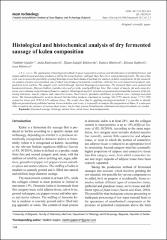Histological and Histochemical Analysis of Dry Fermented Sausage Kulen Composition

View/
Date
2021Author
Gajdov, Vladimir
Radovanović, Anita
Lužajić Božinovski, Tijana
Marković, Danica
Stajković, Silvana
Milošević, Ivan
Metadata
Show full item recordAbstract
The application of histological methods in meat composition analysis and identification of prohibited tissues and
organs added to meat and meat products is still in the research phase, although there have been some promising results. The aim of this
work was to assess the possibility of using histological and histochemical methods for analysis of kulen composition. In this research,
six samples of kulen were examined, one of which was produced in domestic conditions, while the rest were commercial products sampled
from local markets. The samples were carried through classical histological preparation. The obtained slides were stained with
haematoxylin/eosin, Masson-Goldner, toluidine blue and periodic acid-Schiff/alcian blue. The content of muscle, fat and connective
tissue was evaluated using histomorphometric analysis. Histological analysis of kulen composition determined the presence of the following
structures: muscle, adipose and connective tissues, blood vessels, glandular epithelium, peripheral nerve, cartilage and plant
tissue. The histomorphometric analysis showed that the kulen products contained on average 56±2.52% muscle tissue, 7.27±1.38%
connective tissue and 19.82±3.24% adipose tissue. The results show that by applying histological methods it is possible to identify
different permitted and prohibited animal tissues in kulen, and hence, it is possible to analyse the composition of kulen. It is also possible
to confirm the presence of various plant tissues, but for their precise identification, additional histological methods are needed.
